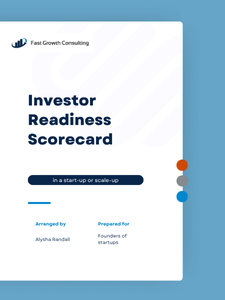
Investors back businesses that can prove they’re financially solid, well run, and ready to scale. So if you’re wondering how to be investor ready finance, this is for you. This post strips out the jargon and gives you simple, practical advice to get your financials in shape before you even book a pitch meeting.
First: What “Investor Ready” Actually Means
Being investor ready isn’t about having a fancy deck with graphs and jargon. It means your financials are:
- Accurate
- Up to date
- Understandable
- Linked to your business model
- Able to stand up to due diligence
In other words, you don’t just know your numbers, you can show them.
And when investors look under the hood, everything works.
Step 1: Get Your Numbers Right First
This is where some of founders struggle.
If your Xero is full of variances, or you can’t explain why your margins jumped 20% last month, you’re not ready.
Here’s what “clean” looks like:
- Bookkeeping is up to date, ideally monthly
- Revenue and costs are categorised correctly
- No big “miscellaneous” accounts
- Cash and Payroll is reconciled
- VAT, PAYE, and other liabilities match what’s due
If your internal numbers don’t match the financials in your pitch deck, investors will walk.
Step 2: Have a Proper Set of Management Accounts
You don’t need to become a finance expert, but you do need a simple report that shows:
- P&L (monthly view for the past 12 months)
- Balance Sheet (current snapshot)
- Cashflow that includes cashburn
This is your core pack. It shows how you’re trading, where the money is going, and how much runway you’ve got left.
If you’re raising within 6–12 months, update this pack monthly. You want to build the habit before investors start asking for it.
Step 3: Know What Your Numbers Say About You
Think of your financials as a mirror. They reflect how well you run the business.
If your revenue is growing, but your margins are shrinking, investors want to know why.
If your burn rate is high, but there’s no customer traction, they’ll ask how you plan to course-correct.
So make sure you can answer:
- Where is your cash going?
- How long is your runway?
- What are your top 3 cost drivers?
- When will you reach breakeven (or what does it take to get there)?
- How does your pricing link to your margins?
You don’t need perfect numbers but you do need to understand what they say.
Step 4: Align Your Forecast With Your Fundraising Story
Your model is one of the first things investors will test. If you’re asking for £2 million, your forecast should show:
- How you’ll spend the money
- How it translates into growth
- When you might need more
Most investor decks have a hockey stick graph. That’s fine, but make sure the forecast backs it up.
Here’s what founders can get wrong:
- The cost assumptions are wildly optimistic
- There’s no allowance for hiring delays or slower sales
- They forgot VAT or holiday pay
- The runway doesn’t match the fundraise ask
If your financial model is tied to your real business plan and not just a funding wish list, then investors notice.
Step 5: Have an Answer for the “What If?”
Investors are not expecting you to know the future, but they are expecting you to plan for it.
That means scenario modelling.
What happens if:
- Sales are slower than expected?
- A key customer churns?
- Hiring takes longer?
- You get less than your target raise?
Founders who think through this ahead of time come across as credible and prepared (because they are!).
What If You Don’t Have a CFO?
You don’t need one full time, especially early on. But you do need someone who can help:
- Clean up your finance systems
- Build or review your cashflow and forecast
- Prepare a monthly reporting pack
- Stress-test your fundraise plan
That’s where a Fractional CFO can be a game changer. It’s what we do for startups and scale-ups at Fast Growth Consulting.
So, how to be investor ready finance? It comes down to three things:
- Clean numbers
- Clear reporting
- Confident explanations
You don’t need perfect forecasts. You need visibility, consistency, and enough financial control to show that ou’re running a serious business.
If you’d like help getting investor-ready either for a raise in six months or to clean up your systems well ahead of time, we’ve got packages that walk you through this, step by step.








